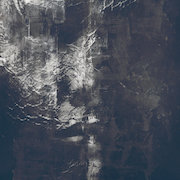The fringes of the Netherlands jazz scene are rather boldly represented by the duo Dead Neanderthals, who in March 2015 released the album, The New Wave Of Dutch Heavy Jazz – though, as expressed in a 2013 interview with tQ, both Otto Kokke and René Aquarius have a penchant for obscenity and blunt contrarianism that are punk’s stylised front. It is easy to stereotype whole projects on the basis of a genre tag, limiting and curtailing the booking prospects of the artists involved, and there always comes a moment when they’re (rightfully) going to start huffing. Preferring the more abrasive sounding genres, Dead Neanderthals also take cues from grindcore and metal – but they wouldn’t want to be limited to any sort of genre convention in the future. Aquarius’ solo work moves more in the direction of ambience and noise – and in a way this isn’t too far off what he has worked on with these other bands; if anything he just runs with particular motifs and moods that you could also see in his drumming work on Night Realms with John Dikeman and Dirk Serries.
In terms of theme and concept (but not in terms of music genre) Blight seems loosely post-industrial in that it imitates the textures that you can make only with the sound of metal, though no longer with that input to create the faltering, rhythmic sound of mass production. That’s not to say that Aquarius’ drumming does not have its own role here – he creates the compositions through drums and cymbals, manipulated with the help of an equalizer, used to create the illusion of distance. More in line with what you might expect from a free jazz drummer, Aquarius doesn’t use percussion to keep time – rather to help provide some variation from within the drone, which sounds as if it is created through an extended cymbal sound; its thin metallic tone made to sound lower in pitch than that of the original instrument.
The album’s title, Blight, is vague but in the context of the sounds used on this album, it makes sense to interpret it as a depiction of the after impact of destruction. It sounds, then, as if the concept behind this project stems originally from some attempt to recreate the sounds of a particular setting, i.e. abandoned industry. The emotional weighting can also be found in its name, definitionally speaking – wilting and disease; to ruin and destroy; strain to the growth and development of life. And the music that results from it still has a ‘mood’, created through the drone and, although it is mainly melody which is associated with the carrying over of a mood, this accomplished without fail here. The drone works in a similar way to a rhetorical ‘emotional demonstration’ for the damnable effects of constant human destruction. Though in this case it would not be via evocation through words, but via the presentation of what that blighted environment might sound like, if you were to have a first personal experience from within it.
Aquarius’ work process has not been openly revealed, but the fact that this project differs from his work in Dead Neanderthals points to a wide palette of influences. Or at least, the desire to communicate a wide range of moods – and maybe gives a reason for why he has changed his approach on this piece of music in comparison to the more melodic work on Night Realms. In a way his solo work might be an extension of the moods that he was trying to put across in his collaborations: where Night Realms is definitely more free jazz, Blight looks to more music concrete as a point of reference, avoiding all melodic structure.
Unlike this album’s contemporaries – with HEXA’s Factory Photographs mostly in mind – the sounds used are not of heavy breakage and metallic cascading but rather barely audible rustlings and clattering effects. While Factory Photographs sounds as if it was created in a wide, exposing yet enclosed environment such as in a large factory space, the reverb used by Aquarius with his drone does not lend itself to this kind of framing. Reverb in its original circumstance as a natural effect used to arise from within a space and was used on a very basic level to replicate the sound of the room in which the piece was recorded in. But on drone/ambient piece like this, digital reverb is used in order to create an illusory room or space that the piece was never directly recorded in. And the use of it here stops Blight from sounding flat, making it a near-synaesthetic experience.


